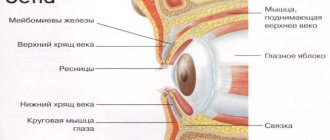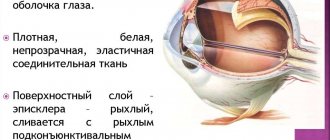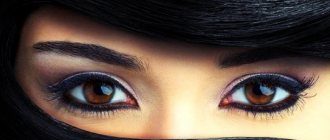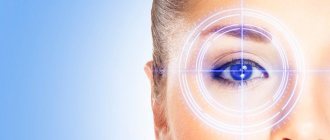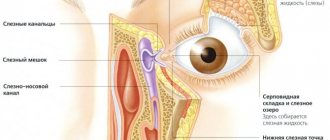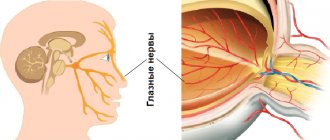Description of gymnastics
In addition to exercises, Tibetan techniques involve the formation of the right psychological attitude, rational distribution of the body's energy resources, and interior design in colors and shapes that have a beneficial effect on vision. In the East, green is considered the most beneficial color for the eyes.
In Tibetan philosophy, human vision is attributed to the forces of the earth element, and its preventive gymnastics promotes the concentration in the eyes of the elements of all other elements, their solitude, which leads to a healing effect.
Despite the pronounced shade of mysticism in this explanation, official medicine does not argue with the benefits of gymnastics, recognizing its relaxing effect.
Most of the exercises from Tibetan techniques are an integral part of classical gymnastic complexes.
The structure of the human energy structure from the point of view of Qigong
The eyes are not the largest organ of our body, but one of the most important in its significance. They open windows to the world for us, they are a “mirror of the soul,” connecting our optical perceptions with emotional experiences.
Eastern philosophy claims that poor vision is a consequence of blockage of energy flow or imbalance of Yin and Yang energies. Qigong is a technique that can help restore energy balance. With regular training, you can significantly eliminate vision problems.
The Qigong tradition dates back thousands of years and includes elements of Taoism, Buddhism and Confucianism. Therefore, there are different schools of qigong. The small circle of energy circulation and qigong exercises for the eyes presented in this article have their origins in Taoist teachings. They belong to the so-called quiet qigong, as they are based mainly on willpower, concentration and imagination.
To improve visual acuity and correct visual impairment, it is very important to first overcome the psychological threshold that exists in most cases and set yourself up for a calm, good mood and daily training.
Qigong has a place of honor in Chinese culture. Qi refers to vital energy, and the word “gong” is translated as work or method. As the sun rises, thousands of Chinese gather in parks across the country. Smooth and leisurely movements restore their inner harmony and balance.
The method of quiet qigong presented in this article was given by master Zhi Changli. While still a six-year-old child, under the guidance of his grandfather, he mastered qigong, kung fu and tai chi chuan. The grandfather was also the owner of one of the largest pharmacies in Hoahot, and he gladly initiated the boy into the secrets of Chinese medicine. For twenty-one years, Master Zhi Changli worked as an acupuncturist and qigong instructor in Beijing. In 1988 he moved to Germany and has been teaching silent qigong in Munich ever since. Qigong exercises for the eyes are an important part of his method.
Almost all of the exercises are done while seated, so you won't need to be very flexible. Anyone can begin to perform them without special training.
Qigong does not require strength. This technique is based on deep inner peace. These are exactly the cases where you can achieve a lot through detachment and relaxation. You study as if you are doing nothing. Observing from the outside, it is impossible to tell whether you are just sitting around doing nothing or practicing qigong. Simply put, one can even argue that if you just sit and at the same time imagine (visualize) something, then this is already quiet qigong. Quiet Qigong attracts with the simplicity and clarity of its exercises, which are performed using the power of imagination. To improve vision using this technique, it is necessary to get rid of physical and mental tension, otherwise the flow of necessary energy will not arise in the body.
A person has energy channels that provide communication with the cosmos. If these channels are not blocked by anything, then the person is healthy. Silent qigong successfully maintains your energy level, strengthens the immune system and, due to this, creates the prerequisites for good vision. The goal of qigong is to improve the health of the body as a whole, but exercises to restore vision are aimed specifically at the eyes, around which important energy points are located.
Of course, the greatest success can be achieved with the integrated use of qigong techniques. To do this, you must first enter the state of qigong, that is, achieve mental and physical peace, and then gradually increase your energy potential with the help of a small circle of energy circulation, in order to subsequently purposefully move on to eye exercises. At the end of this material, there will be tips that you should consider in everyday life, such as when working at a computer or when driving a car, to give your eyes the rest they need from time to time.
Jing, Qi, Shen - three jewels
The word “Qi” in Chinese culture denotes the dynamic force that controls all functions and processes in space, the human body, the animal and plant world. Qi is life energy. Shen is translated as spirit, and Jing is translated as essence. These three jewels are present in every living being. The life activity and development of the human body are based on them. Together with Yin and Yang energy, the five elements and energy channels, they form the basis of traditional Chinese medicine. Qigong is closely related to Jing, Qi and Shen. It strengthens the body, gives strength to the mind and lengthens life.
It is not possible to give a certain linear description of Qi, as we are used to in the West, even if only by looking at the Chinese character that denotes Qi. In Japanese culture there is a similar concept of Ki, and in Indian culture there is prana. Thus, throughout the eastern cultural space, traditional medicine is based on ideas about the flow of energy in a certain system. In China it is Qi and the meridian system; in Japan - Ki and the kairaku system, in India - prana and the nadis system.
Since human energy channels with their fine structure cannot yet be detected by conventional means of modern science, they have not yet received widespread recognition. However, acupuncture, also based on the meridian system, is already widely used in the West to treat allergies and drug addiction.
Qi is life. It is everywhere. When we eat, we absorb Qi into ourselves. Qi is inherited from our parents, and depending on the place of birth, vital energy will be different. With training and the power of imagination, Qi can be made even stronger.
Heaven, earth and man form a unity. A person can absorb and accumulate the Yang energy of heaven and the Yin energy of earth. The main store of energy is the so-called lower tan tien (brain in the stomach), which is located in the area of the pubic bone. The middle tan tien is located in the chest area at the level of the nipples and is responsible for our emotional world. The upper tan tien is placed between the eyebrows. It is also called the third eye, and it has enormous significance for us as the center of the soul.
A person constantly gives away used energy and receives fresh energy. Three entrances are of particular importance: the gate of earth, the gate of man and the gate of heaven. The gate of the earth is located in the middle part of the foot behind the pads of the toes, the gate of man is in the middle part of the palm, and the gate of heaven is in the center of the cranial vault, on the crown of the head. Also of great importance is the Hui Yin point, or perineal point, which connects the gate of earth to the gate of heaven through the central channel.
Qigong is a holistic technique that allows you to bring the flow of Qi into harmony. From the point of view of qigong, disease is either a lack or excess of energy in the channels. Qigong exercises activate the healing processes occurring in the body. As a result of long and intense training, you can develop the ability to direct energy where it is most needed. An important condition for practicing qigong is to achieve a state of qigong - calm, inner peace, good mood and relaxation. You should smile at least seven times a day and constantly imagine that, like tiny suns, all the pores of your skin (and you have eighty-four thousand of them!) are smiling. Your joints, organs, lower tan tien, middle tan tien and upper tan tien smile. A smile merges with good energy, spreads across the room, grows, embracing everything around, and reaches the limits of space.
Energy flows in the human body through energy channels. Quiet Qigong, as already mentioned, is based on the meridian system, which is also used in acupuncture. During an acupuncture session, needles are inserted into energy points to remove the blockage of the channels. In quiet qigong, such blockages are removed by influencing the flow of qi through the power of imagination.
The yin meridian (zhen-mai, the servant's vessel) runs along the front surface of the human body, and the yang meridian (du-mai, the master's vessel) runs along the back, along the spine. They are called royal lines and are of great importance, connecting Yin and Yang.
There are six pairs of meridians (twelve in total) in our body, as well as eight special meridians. There are three yin meridians on the inside of each arm, and three yang meridians on the outside. In the same way, there are three yin meridians on the inside of the legs, and three yang meridians on the outside.
The meridians end at the nail bed.
Thumb >> Yin Meridian >> Lungs
Index finger >> Yang meridian >> Large intestine
Middle finger >> Master of the heart, yin meridian >> Coronary vessels of the heart
Ring finger >> Three warmers >> Upper and lower body
Little finger >> Yin-Yang meridians >> Heart, small intestine
Meridians also end at the toes
Thumb >> Yin Meridian >> Spleen, Liver
Second finger >> Yang meridian >> Stomach
Fourth finger >> Yang meridian >> Gallbladder
Little finger >> Yang meridian >> Bladder
Midfoot >> Yin Meridian >> Kidneys
The eyes are also part of a complex system of meridians. In the area of each eye there are eight energy points associated with the meridians.
Based on materials from the book “Therapeutic Qigong for the Eyes” by Inka Yochum
Source:
Exercises for glaucoma
To combat pathological disorders of intraocular pressure, it is important to relax your eyes well. This is achieved by the following exercises:
- Two fingers are placed in front of the eyes at a distance of 50 centimeters, the eyes focus on them, then the fingers are moved apart while maintaining the focus of the gaze. The benefit of this exercise is that it gives the visual muscles a specific load that they practically do not receive during normal work.
- Contrast between near and far focus. The index finger is brought close to the face (20-30 cm), and both eyes look at it for a while. Then the focus changes and is fixed on some distant object, for example, on houses or trees outside the window, on a flying bird.
- The gaze concentrates on the outermost lateral point (without turning the head) on the left, then moves to the right.
- Circular pressing movements are carried out in the areas of the bridge of the nose (where it turns into the eyebrow arches), on the eyebrow arches themselves. In the absence of conjunctivitis and other damage to the eye shell, you can press on the sclera itself; to do this, you need to close your eyes and lightly press your finger on the cornea area for 2-3 seconds. Before such actions, hands must be clean, preferably moistened with cool water (it enhances the tonic effect).
- Press your nose to a smooth surface and “write out” geometric shapes with it. This combines the effects of previous exercises: the impact on the visual muscles occurs both by changing the focus of the gaze and by external massage.
Contraindications when performing eye gymnastics
Any exercise is only good when done in moderation. When performing eye exercises, you should strictly adhere to the doctor’s instructions. The fact is that in a number of diseases, for example, cataracts or anatomical myopia, excessive mechanical impact can cause harm to the visual apparatus.
And a healthy person does not need to overdo it. For prevention, a one-time daily set of exercises and eye massage is enough. Numerous repetitions will not have the desired effect.
Originally posted 2018-02-27 06:57:09.
Gymnastics for cataracts
The effectiveness of such preventive measures for cataracts is not so high, since it is more often caused by internal pathologies of the eyes and the body as a whole. But Tibetan practices in this case can well complement the main treatment.
These practices include exercises such as:
| 1 | You should blink frequently for a minute. This exercise not only tones, but also moisturizes the eyes. |
| 2 | Close your eyes tightly and do not open them for 5-10 seconds. Repeat several times |
| 3 | Close your eyes, press your fingers on both eyelids and pull them up, while maintaining tension in the visual muscles to keep your eyes closed |
| 4 | Change of focus used in glaucoma. Focus on an object near you, then on another one further away from you. |
Tibetan eye gymnastics for myopia and glaucoma.
Color background for the eye.
Green is the most favorable color for the eyes to relax, so when working at the computer, always place a green plant near the monitor. So, under significant loads, you can always spend 5-10 minutes to relax your eyesight.
Massage.
After every 3-4 hours of intense work, or simply when your eyes are tired. Do the following massage procedures with smoothing the upper and lower eyelids and pressing on the sclera. It is recommended to perform rotations as well. When performing the exercise, close your eyes. Tibetan eye gymnastics is aimed at both preventing diseases and treating them.
Other exercises
In Eastern practices, contemplation of a candle is common. Take an ordinary candle, light it, and place it in a fairly dark room. You should continuously focus your gaze on it until the first signs of tearing appear.
Then the eyes rest twice as long. This exercise relaxes the muscles of accommodation and moisturizes the eyes, and is also beneficial for the human psyche.
Cool water is poured into a plate or basin. The eyes are closed and the face is plunged into the tank for a few seconds.
To normalize vision, massage not only of the visual muscles, but also of the temporal and frontal parts of the head is useful. Make pressing circular movements with your fingers in these places - this will relax you and improve blood circulation in your head.
The following video shows another gymnastics exercise:
A little practice
Mount the mandala design on the wall so that the center point is at the level of your nose and at a distance of 10 cm to 15 cm when you sit on a chair. 30 minutes before the start of relaxation, remove your glasses or contacts if you wear them to correct your vision defect.
- Sit upright and turn your eyes clockwise, moving your gaze from one top point to another (6 points in total) until you make a full circle. Keep your head straight, move only your eyes. Do the same counterclockwise. Repeat all movements several times until you get tired. Then, blink your eyes a few times and relax.
- Place your palms over your eyes: your right palm over your right eye and your left palm over your left eye. Let your fingers rest on the bridge of your nose. Place your elbows on the table or on your knees. You should feel the calming darkness. When you feel the warmth of your hands, send a free flow of energy from your hands to your eyes. Then close your eyes and let them rest for 3 to 5 minutes. When you open them, you should feel clearer vision than before training, at least for a moment.
- Slowly direct your gaze to the right point of the graph, and then to the left, and so on several times. Stop as soon as your eyes get tired. Then blink a few times, stroke your eyes with your fingers, close and give them time to rest for 3 to 5 minutes.
Practice eye exercises daily morning and evening to improve your vision and get rid of bags under your eyes.
Phurba
Complete eye restoration with Tibetan gymnastics. Play the online video “Phurba” and follow the prompts:
- Observe the pattern through the opening of the moving ring.
- Expand the image to full screen, dim the light and close your eyes slightly. Feel how the light strips tense the micro muscles of your eyes. Then give them time to relax.
For complete recovery, it is recommended to additionally use simulators: ophthalmological and “Slogodsky MNOT”.
Eye of the Dragon
Developing peripheral vision by observing moving objects. All exercises must be performed without glasses or contact lenses. Peripheral vision is so important that if we didn't use it, we would end up with tunnel vision. The Dragon's Eye class allows us to discover the gift of clairvoyance.
- Turn on the video and very carefully watch the movements of the small circle along the closed line, ignoring the transparent outer circle.
- Close your eyes and watch the images emerge.
A
Shaman's Bonfire
Looking at the fire, the shamans “revitalized” the drawings. Turning their gaze to the rock painting, by an effort of their will they visualized their movement. By controlling attention, the shamans forced those around them to see these movements. These skills helped them create and “show” to others any controlled images.
- Play the online video “Shaman’s Bonfire.”
- Concentrate your gaze on the center of contrasting black and white moving objects.
Life Knot
Like the Shaman's Bonfire, the Knot of Life technique is used not only to heal the eyes, but also to charge them with life energy.
- Turn on the online video and carefully watch the movement of the small circle.
- Observe the imaginary images that appear before your half-closed eyes.
Eight
The Figure Eight exercise for the eyes trains central fixation skills and develops peripheral vision.
- Carefully follow the movement of the small circle along the figure eight line, without noticing anything around, including its upper shell.
- Close your eyes and watch the imaginary images appear before your closed eyes.
Results
Tibetan gymnastics is a set of contrast therapy methods for the eyes, which consists of alternating loads in different directions and relaxations, which increases the tone of the visual muscles and increases their performance, and also prevents their fatigue.
A significant part of the exercises that make up this gymnastics has been adopted by modern medicine.
The technique is most effective for glaucoma, cataracts and myopia. Gymnastics is not performed for eye injuries and in the later stages of myopia.
A set of exercises to restore vision
Basic Rules
To use the Chinese method with maximum efficiency, you must follow these recommendations:
- The optimal duration of the treatment course is 2-3 months. You should exercise every day.
- Nothing should distract you from your workout.
- You can’t train if you’re in a bad mood or feeling bad. It is recommended to reschedule the session or first calm down with the help of relaxing music and herbal infusions.
- It is best to practice in the morning, combining eye qigong with exercise.
- When performing exercises, the muscles completely relax. Tightness interferes with the proper circulation of Qi energy.
- Clothing should be light and not restrict movement. Natural fabrics are best suited.
- The room is ventilated before training.
Complex for improving vision
Qigong should not cause discomfort or overexertion. If painful sensations appear, the training is interrupted. In the future, the number of repetitions should be reduced.
The effectiveness of training depends on proper breathing.
Classic Chinese training includes the following exercises, which can be performed in any order:
- Pendulum. In a standing position, you need to lean against the wall. The head is straight, the back of the head is adjacent to the surface. The neck is fixed in one position.
- As you inhale, your gaze moves as far as possible to the left, and as you exhale slowly, it moves forward. Mild ligament pain is a normal reaction.
- Likewise in the other direction.
- The number of repetitions is 5-10 times.
- The situation does not change.
Systematic performance of the simplest movements will help restore vision.
- Infinity. The situation does not change.
- As you inhale, your gaze moves down and to the left, making a semicircle.
- Then he completes the figure eight.
- As you exhale, return to the original position.
- The speed increases with each repetition.
- Duration - 3 minutes.
- The starting position does not change.
- The situation does not change.
Qigong massage technique
Movements are smooth and soft.
The preparatory stage is relaxation. You need to take a deep breath and rub your palms to create a feeling of warmth. It is recommended to do a separate warm-up for each finger. Eye massage is done according to the following scheme:
- The index and middle fingers gently press on the centers of the closed eyelids. Touching should not cause pain. Number of repetitions - 8 times.
- At the same time, the corners of both eyes are warmed up, then the inner ends of the eyebrows, the middle and outer points.
- Points under the lower eyelids are massaged.
- The point between the eyebrows is pressed hard.
- Using the thumb and middle index finger, pinch the eyebrows from the inner extreme point to the outer one.
- Number of repetitions - 8 times.
After the massage, it is recommended to move on to therapeutic exercises, but you can practice the technique separately. Impact on biologically active points normalizes blood pressure, accelerates blood flow and metabolic processes in the eye area. The technique can additionally be used to combat headaches.
Rules for Tibetan gymnastics
The main task of a patient starting to perform exercises according to the Tibetan method is to master the rules of working with his own energy.
The ability to create a certain atmosphere and environment during classes will allow you to achieve a positive result in the shortest possible time.
A person's eyes are one of the many energy centers of his body. During classes, green colors should be present in the environment. For example, you can place a green houseplant in your field of view. This color helps to calm and relax the muscle tissue of the organs of vision.
It is important to remember that visual impairment can occur for a variety of reasons. In addition to long-term visual stress, these include:
- Smoking.
- Alcohol abuse.
- Poor nutrition.
- Incorrect organization of workplace lighting.
- Hereditary ophthalmological diseases.
- Injuries to the visual organs.
Therefore, to improve vision, it is important not only to do eye exercises, but also to normalize your diet, give up bad habits, and provide high-quality lighting on your desk.
It is possible to achieve excellent results only in case of minor vision deviations. Therefore, the sooner a person starts doing gymnastics, the better.
Performing exercises for severe visual impairment will help prevent further progression of the disease.
You also need to take into account that if you have certain diseases and conditions, doing gymnastics is contraindicated.
Vision treatment and qigong
The eyes are the main organ of perception. It is directly connected to the brain. It is important to maintain functional vision in order to clearly see and perceive phenomena and objects. As the qigong master Yi Zhou notes in his works, based on many years of practice, if you continue training for a long time, this will have a positive effect not only to protect the eyes and increase the power of vision, but also to improve memory, mental abilities, increasing the resistance of the whole body and improving health.
There are three exercises for working with vision in qigong:
- to improve vision;
- for myopia;
- with farsightedness.
How to help the lens
So why can the lens become cloudy? Let's list the main reasons:
- The main optical lens of the eye does not have its own blood supply and is fed from the surrounding ocular fluid. Its composition (excess sugar, toxins during inflammation, etc.) affects the structure of the lens and can cause clouding.
- The capsule containing the lens is suspended inside the eye by ligaments that connect it to the ciliary muscles. When these muscles work weakly, the lens loses its ability to actively move, increase or decrease its optical power.
So, in order for the lens to maintain transparency and elasticity, it requires good blood supply, an influx of nutrients, and normal tone of all the muscles of the eye. Such conditions can delay the development of cataracts for many years - for this purpose, various training methods and sets of exercises have been created: yoga, Tibetan eye gymnastics for cataracts, V.M. Zhdanov’s complex, M.S. Norbekova, recommendations of traditional medicine. They all stimulate the same processes:
- rest and relaxation after prolonged strain on the visual apparatus;
- inclusion and training of various eye muscles;
- accommodation training: transition from their “working at a distance” mode to the “working near” mode;
- stimulation of metabolism;
- improving blood supply through massage of the eyelids and eyeball;
- rinsing the eye with tears to clear away accidental infections and contamination.
Tibetan technique
Tibetan eye gymnastics for cataracts is similar to a yoga complex; a few comments can be added to it:
- the optimal time for eye training is morning;
- to relax and rest your eyes, you need to use green more often;
- After exercise, it is advisable to immerse your entire face in cold water.
Let's look at the technique itself:
- Tension-relaxation: close your eyes tightly, then with your eyes closed, tense and relax them.
- Pressure: with your eyes closed, press your fingers quite firmly on the eyeball.
- Massaging: placing your middle finger on your index finger, massage your closed eyes in a circular motion.
- Lightly pressing on the eyelids of your closed eyes, try to open them, overcoming the resistance of your fingers.
- At the window, look at a close object, then move your gaze into the distance, changing the conditions for focusing your vision. Each fixation of gaze on objects near and far lasts up to 5 seconds.
- To relax and rest after each exercise, use the technique of quick and light blinking.
Each exercise is done 10-15 times, the massage is performed for 1 minute.
